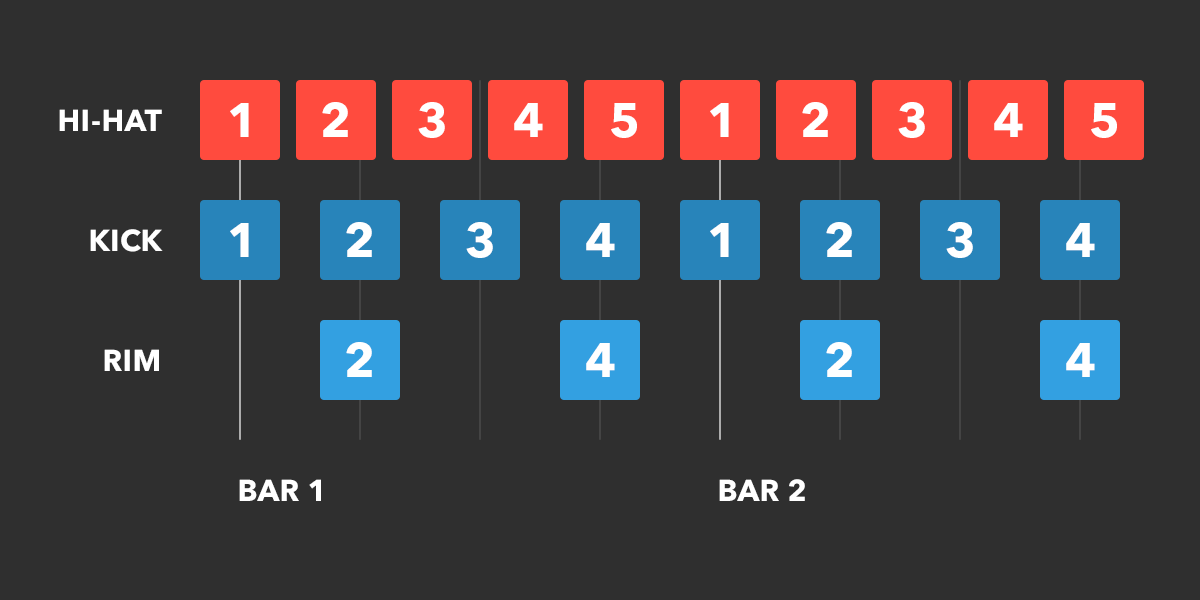Why the grid matters…
It probably goes without saying that the ultimate goal of writing and producing music is to express ideas, emotions, and thoughts with the rest of the world; to translate your thoughts into sound and share them. Simple enough! But of course, each of the sounds bouncing around in your head requires a system for putting them down on paper, or more likely today, into your digital audio workstation. It’s also most likely safe to say that your ideas, feelings, and thoughts on music are complex, free flowing, and full of meaning. Over the past several hundred years, we’ve developed a grid-like system for writing down rhythms and note relationships. This system is based on multiples of two, and produces very organized rhythms and beats when you use it. A lot of the time, it works just fine! But if you want to really take your ideas and musical statements to the next level, breaking out of the “grid” is exactly what you want to do…
…and why you should get off-grid!

The grid is important, but don’t feel trapped by it!
As you might remember from our previous post on “Breaking-Up the Grid” we talked about the curious “Triplet” which is certainly trending in music production. Triples are simply three notes, equally spaced where two or four would occur. In this way, we’re stepping out of the “multiple-of-two” system, and making rhythms which go outside that. As you can imagine, this technique is pretty popular! Triplets are also part of a larger family of grid-smashers, known as “Tuplets,” where you can place any number of beats into a space where they wouldn't fit normally due to the grid’s unforgiving walls. This could be seven beats in the space of eight, or even thirteen!
If your heart demands it, Tuplets can free you to place beats in just about any space. While that’s all well and good, it’s important to mention that playing a “Tuplet” refers to just a single voice, and that putting multiple grid-based and non-grid rhythms on top of each other is something else altogether: the polyrhythm.
What about polyrhythms?
To begin, polyrhythms aren’t really all that complicated when you look at the big picture. They consist of two different voices, each playing with what is perceived as a fundamentally different pulse. This can also be expressed as a ratio. For example, you could have a pulse of two, playing with a pulse of three, making a 3:2 polyrhythm. In fact, this is a very special polyrhythm known as the “hemiola.” This polyrhythm plays an important part in music from many different genres from Afro-Cuban Jazz, Classical, Techno, Hip-Hop, Balinese Gamelan, and beyond.
When you use a tuplet of some kind, like a triplet, as long as this voice is not the only thing playing, you’ll get a polyrhythm. Sometimes we talk about polyrhythms as one voice performing a grid-based (sometimes called “rational”) rhythm, and the other performing a non-grid based (also called “irrational”) rhythm on top. There can be longer form polyrhythms too though, which due to their length, can fit within the musical grid. This would be something like two voices going over several bars of music to fit in the correct polyrhythm.

A 5:4 polyrhythm.
A visual example.
In this example, we can see a 5:4 polyrhythm. Each box represents a beat, and over the course of a bar, the red voice pulses equally five times while the blue voice pulses four times. Listen to the example audio to hear it out. The hi-hat will play the red “irrational” rhythm on top of the kick and rim-shot.
Cross-rhythms
In other cases, we use the term “cross-rhythm” which is sometimes used in polyrhythm’s stead, but references a specific musical context. In a cross-rhythm, the polyrhythm continues uninterrupted through out the song. In the song “Odessa” by Caribou, you can hear a hemiola-like baseline rhythm, which sounds like it resets itself every bar. In the case of a cross-rhythm, this would continue onward without re-starting.
In these two audio files, listen to how this 3:2 polyrhythm also known as a hemiola, can sound if it’s a cross-rhythm. Can you hear the polyrhythm pulse without repeating over the length of a single bar?
Hemiola Poly example
Hemiola Cross example
All-in-all, polyrhythms play a crucial role in making music. They expand our musical vocabulary, and give producers, composers, and players alike a whole new realm of possibilities when making music. On top of that, polyrhythms neatly describe some of the weirder rhythmic relationships found in music, allowing us to focus on them, study them, and use them for amazing musical possibilities. Want to train your ears even further? Try checking out our playlist on polyrhythms! We’ve dug deep to curate several of the most striking examples out there. See if you can pick out the polyrhythms in each track!
Related:

Playlist: Polyrhythms.
Welcome to Melodics’ curated playlist on polyrhythms! This playlist has some rare and stunning cuts in it to make you a pro on polyrhythms faster than a 7:8 cross-rhythm! As you listen, try pinning your ears to possible polyrhythmic sounds. They can be trickier to find than you might expect!

